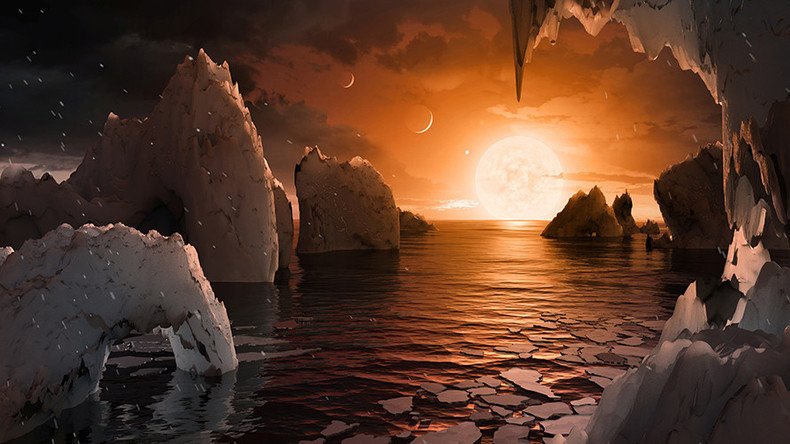NASA exoplanet discovery ‘is just a beginning’

With the discovery of seven new planets, astronomers now have a target to point their more powerful telescopes at, to see if they have atmospheres in which biological life could survive, says Robin Seemangal, space reporter for the New York Observer.
Scientists from NASA and the European Southern Observatory made a major breakthrough in the search for earth-like planets. They detected seven Earth-size planets that could potentially have conditions for life. The exoplanets orbit a supercool dwarf star, Trappist-1, which is about 40 light-years (235 trillion miles) from Earth, in the constellation Aquarius – relatively close to us.
Announcing the discovery, a NASA official said this “gives us a hint that finding a second Earth is not just a matter of if, but when.”
Is there life beyond #Earth? #NASA has just made a ‘giant leap’ in trying to answer this question https://t.co/ANeTEG8pdSpic.twitter.com/6plJS4iaRZ
— RT (@RT_com) 22 февраля 2017 г.
Robin Seemangal agrees that “this is just a beginning.”
“There are billions of galaxies out there. Each galaxy has billions of stars. Now that we’re discovering these habitable worlds, which only started about in the last 30 years or so. We’ve started frequently finding them even more recently. In 2018, when NASA launches the James Webb Space Telescope, we’ll be able to point that telescope at these potentially habitable worlds, and figure out if there is water vapor in the atmosphere, or there are by-products of life, and especially water. That is what’s important about this discovery, that now we have a target to point our more powerful telescopes at in the future to detect those chemicals and detect the atmosphere where biological life could survive,” he told RT.
While these planets are 40 light years away, it is still “definitely possible” to detect life at such a large distance, according to Seemangal.
“We just need more powerful telescopes. Those telescopes are on their way. In the next few years we’re definitely going to have more sensitive infrared telescopes. Infrared was what was used to detect this Sun and the planets around it,” he said.
Going to these planets is a different story, the space reporter added.
“Going at the speed of light will take 40 years still. It is trillions of miles away. I can’t say how long it would take for humanity to accomplish that, but likely maybe in the future we can send robotic representatives instead of humans,” he said.
‘At least one of 7 planets could be habitable’
It is possible that at least one of the planets could be suitable for life in some way, says Thayne Currie, astronomer at Subaru telescope.
“The problem is that we don’t know that much in detail about the atmospheres of these planets. One of these has been more characterized. In other cases we have light curves that give us a sense of roughly what the size of the planet is. But to really tell for sure we need to follow up spectra of these planets that might be obtained with James Webb Space Telescope that will be launched in 2018,” he told RT.
In his opinion, the detection of the seven exoplanets is “rather decisive.”
“[NASA] used data obtained from Spitzer Space Telescope; they used data obtained from the Hubble Space Telescope, from telescopes in Hawaii here in the US, and also in Chile. All these telescopes together showed evidence for multiple planets around the star. So I think the detection is rather decisive. I think what is still a bit uncertain is what the properties is of these planets are in terms of their atmospheres. We really don’t know right now,” Currie said.
‘Extremely exciting’
The discovery of the new planets is “extremely exciting,” says Jason Wang, astronomy graduate student at UC Berkeley.
“It is interesting not only from a perspective of looking at their atmospheres to see what kind of planets they are, but also how do they form; how do we get seven of these planets so compact in such a system,” he said.
These newly discovered planets are believed to have the right temperature for liquid water. RT asked Wang, known for creating exoplanets animation, what kind of life he could imagine on these worlds.
“I don’t even know where to speculate just because we only know one kind of life and that is Earth life... How we imagine this world... red-dwarf stars, if they are illuminated by the star and they all will be very red. It wouldn’t be like our sky – very blue. So these dwarfs will be a lot redder,” he said.
The statements, views and opinions expressed in this column are solely those of the author and do not necessarily represent those of RT.












